Python语法总结
Python数值计算
算术运算种类:+(加) -(减) *(乘) / (除) **(幂次) % (取模)
a=10/3
print(a)
b=10%3
print(b)
赋值运算:
= += -= *= /= %= **=
c**=a
c=c**a
逻辑运算:
and 与 or 或 not 非
查找运算符:
in
not in
身份运算符:
is
简单基本函数:
is not
类型运算符 type()
取绝对值 abs()
取整函数 round()
取最值函数 max() min()
地址运算符 id()
科学计数法:
8e5
8*(10**5)
三元运算符:
=
1 if
2 Result = a if a>b c
强制类型转换:
常用数据类型:DATATYPE
等
价
于
在
指
定
序
列
中
不
在
指
定
序
列
中
用
于
判
断
两
个
标
识
符
是
否
来
自
同
一
内
存
空
间
等
价
于
结
果
值
条
件
值
�
int
float
str
bool (true false)
类型转换方法:
DATATYPE(Num)
a='123'
type(a)
输出:str
float(a)
输出:123.0
3>3
输出:False
max(1,2,3,4)
输出:4
min([1,2,3,4])
输出:1
max,min既可以操作数组又可以操作列表
Python字符串操作(str)
python
‘ ’ , “ ”
str="Hello python" ##双引号必须用英文格式
要
求
字
符
串
必
须
使
用
引
号
括
起
来
,
使
用
单
引
号
也
行
,
使
用
双
引
号
也
行
注
意
:
字
符
串
对
象
是
不
可
改
变
的
,
也
就
是
说
在
创
建
一
个
字
符
串
后
,
你
不
能
把
这
个
字
符
中
的
某
一
部
分
改
变
。
任
何
下
面
的
函
数
改
变
了
字
符
串
后
,
都
会
返
回
一
个
新
的
字
符
串
,
原
字
串
却
并
没
有
变
。
字
符
串
创
建
:
使
用
引
号
括
起
来
�
字符串拼接:
+
str1="Hello"+" "+"Python"
print(str1)
输出:Hello Python
字符串乘法:
*
str="Hello"*3
print(str)
输出:HelloHelloHello
字符串长度计算:
len()
len(str)
输出:15
数值转化字符串:
repr()
a=12
b=repr(a) ##使用str函数报错
print(b)
type(b)
输出:12
字符串核心操作:
字符串切分为列表:
str.split()
str="1 2 3 4 5"
str.split()##以空格为界进行拆分
输出: ['1', '2', '3', '4', '5']
使
用
加
法
表
示
复
制
使
用
函
数
使
用
使
用
函
数
�
str="1,2,3,4,5"
str.split(',') ##以逗号未拆分
输出: ['1', '2', '3', '4', '5']
字符串聚合:
使用str.join(str1)函数
str1
str(
)连接生成一个新的字符串*
str='hellopython'
str_blank=' '
str_blank.join(str)
输出: 'h e l l o p y t h o n'
字符串替换:
使用str.replace(str1,str2)函数
str1
str2
str="hello python"
str.replace("python","guo")
输出: 'hello guo'
字符串去首尾空格:
str.strip() 去掉str首尾空格 str.lstrip() 去掉str首空格 str.rstrip() 去掉str尾空格
str=" hello python "
str.strip()
输出: 'hello python'
str.lstrip()
输出: 'hello python '
str.rstrip()
输出: ' hello python'
字母大小写替换:
str.upper() 字母转换为大写
str.lower() 字母转换为小写
将
字
符
串
以
指
定
的
字
符
分
隔
符
注
意
使
用
顺
序
替
换
为
替
换
只
是
浅
替
换
�
str="hello python"
str.upper()
输出: 'HELLO PYTHON'
str.lower()
输出: 'hello python'
查找字符串:
str.find(str2)
查找字符串str中str2的索引
str='hello'
str_1='el'
str.find(str_1)
输出: 1
Python数据结构索引
从前面是从0开始
从后面是从-1开始
str="hello python"
str[2]
输出: 'l'
str[-3]
输出: 'h'
切片操作,也叫冒号操作
切片 :
表示从哪到哪,左闭右开的区间
str[0:4] 表示 str[0]--str[3] str[1:-2] 表示从第一个到倒数第二个 str[:7] 表示从第一个到第六个 str[-2:] 表示从倒数
第二个到最后一个 str[:] 表示取所有 str[::2] 表示每隔两个取一个 str[::-1] 表示翻转
�
str[0:4]
str[1:-2]
str[:7]
str[-2:]
str[:]
str[::2]
str[::-1]
输出:'nohtyp olleh'
Python列表(list)
python列表类似于c中的数组 python的列表是比较强大的,它包含了很多不同类型的数据:整型数字,浮点型,字
符串以及对象等 没有长度限制
列表创建:
[] list([]) ##该方法可能报错
list_1=[1,2,3,4,5]
list_1
输出:[1, 2, 3, 4, 5]
列表核心操作
列表长度计算: len(list)
列表扩展: list_1+list_2
列表复制: list*3
列表索引: 冒号:索引
列表元素删除 del list[Num] 删除list的索引为Num的元素
list=[1,2,"python",3.4]
del list[1]
list
输出:[1, 'python', 3.4]
相同元素计数:
list.count(str) 统计list中str的个数
list=[1,2,3,5,4,2,4,2,3,5,4,3,4,5]
list.count(1)
输出:1
�
获取指定元素的索引:
list.index(str) 获取list中str的索引、 注意list中没有find函数操作
list.index(2)
输出:1
列表元素添加操作:
list.append(element) 在list中添加元素element element可以是字符串,列表
列表元素移除:
list.remove(element) 在list中移除元素element element可以是字符串,列表,remove移除后原列表改变
列表元素获取:
list.pop(element) pop只能弹出某个元素,原列表不会变
list=[1,2,3,4,5,6]
list.remove(2)
list.pop(3) ##pop弹出后,list中将没有该元素
list
输出:[1, 2, 3, 5, 6]
列表元素排序:
list.sort() list_1=sorted(list) 对list内元素排序 列表元素逆序:list.reverse() 注意:逆序操作目前只适用于字符串
list_1=[2,3,1,23,4,2]
list_1.sort()
list_1
输出:[1, 2, 2, 3, 4, 23]
list_2=["hellopython",'kaishi']
list_2.reverse()
list_2
输出:['kaishi', 'hellopython']
Python字典
�
字典(Dictionary)在Python中是一种可变的容器模型,它是通过一组键(key)值(value)对组成,这种结构
类型通常也被称为映射,或者叫关联数组,也有叫哈希表的。每个key-value之间用“:”隔开,每组用“,”分割,整个字
典用“{}”括起来
字典的创建:
括号法:dict={"key":value,....} dict_1=dict()
注意: 定义字典时,键在前,值在后,键必须唯一性,值可以不唯一,如果键有相同,值则取最后一个; 值可以是
任何的数据类型,但是键必须是不可变的数据类型(数字、字符串、元组);
字典核心操作:
访问字典中某一键的值:
dict[key] 注意字典存储并无顺序可言,而且只能用键值索引 dict.pop[key]
访问字典中的属性:
dict.keys() dict.values() dict.items() 上述数据都是要以列表形式返回
字典中增加键值:
dict[new_key]=newnumber 在字典中添加新键new_key,对应新值newnumber
字典中删除键值:
del dict[key] 删除键key
清空字典:
dict.clear()
字典的更新:
dict.update(dict_1) 用dict_1更新dict 但是dict_1不变
字典的查找:
dict.get(key_1,"Not exist") 在dict中查找key_1,不存在返回Not exist,存在即输出键的值
dict_1={"c":12,"python":11,"java":10}
dict_2={'cuda':3,'matlab':30}
list_1=dict_1.keys() ##获取python的键
print(list_1)
list_2=list(list_1) ##使用list()将字典类型的键转为列表结构就可以进行索引
print(list_2)
print(list_2[1])
输出: dict_keys(['c', 'python', 'java'])
['c', 'python', 'java']
python
dict_1['c']
输出: 12
�
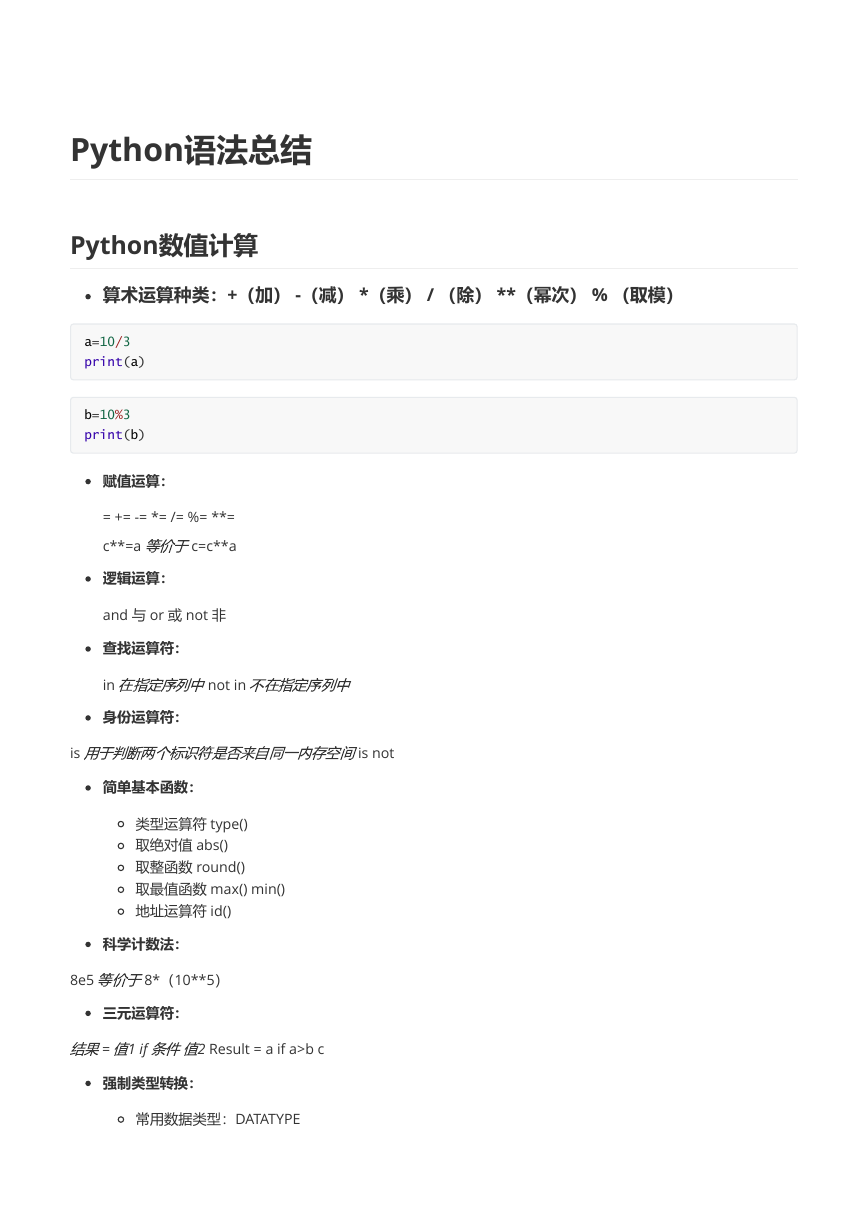

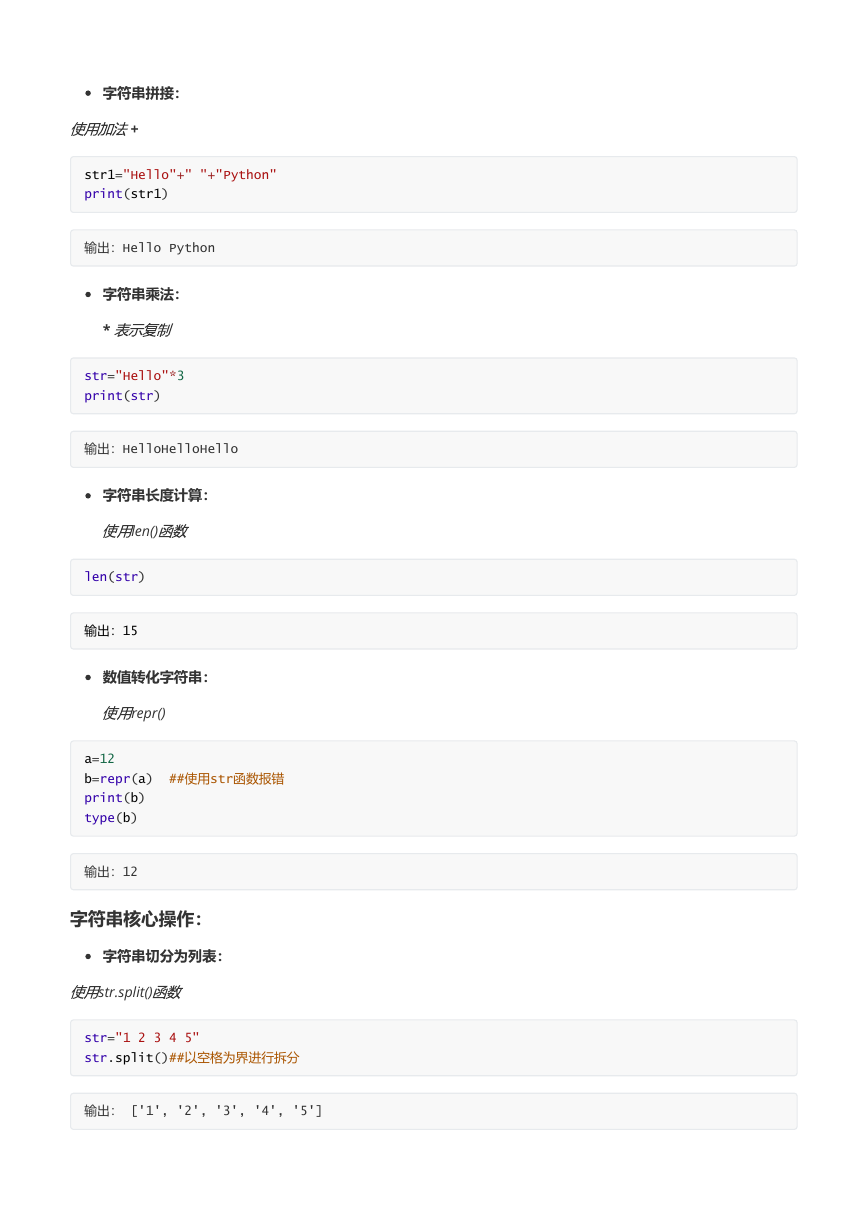
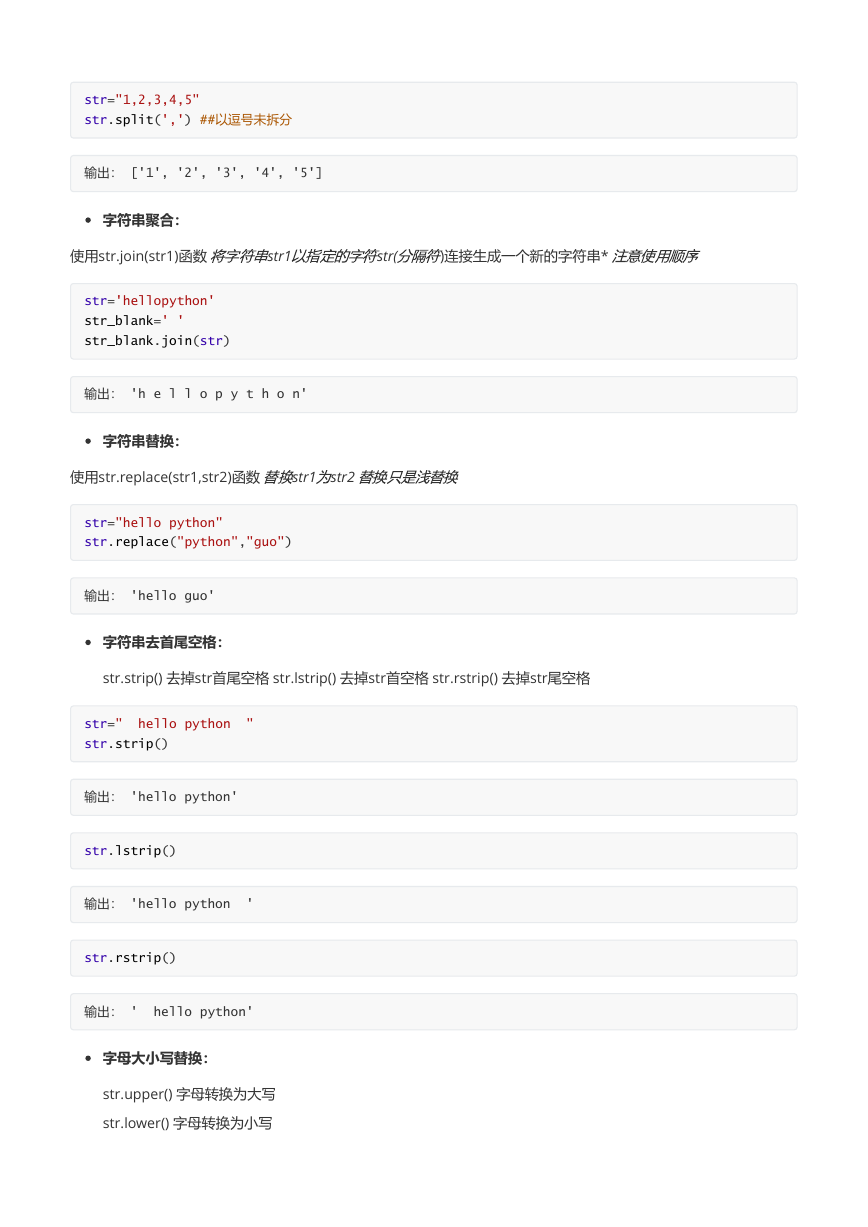
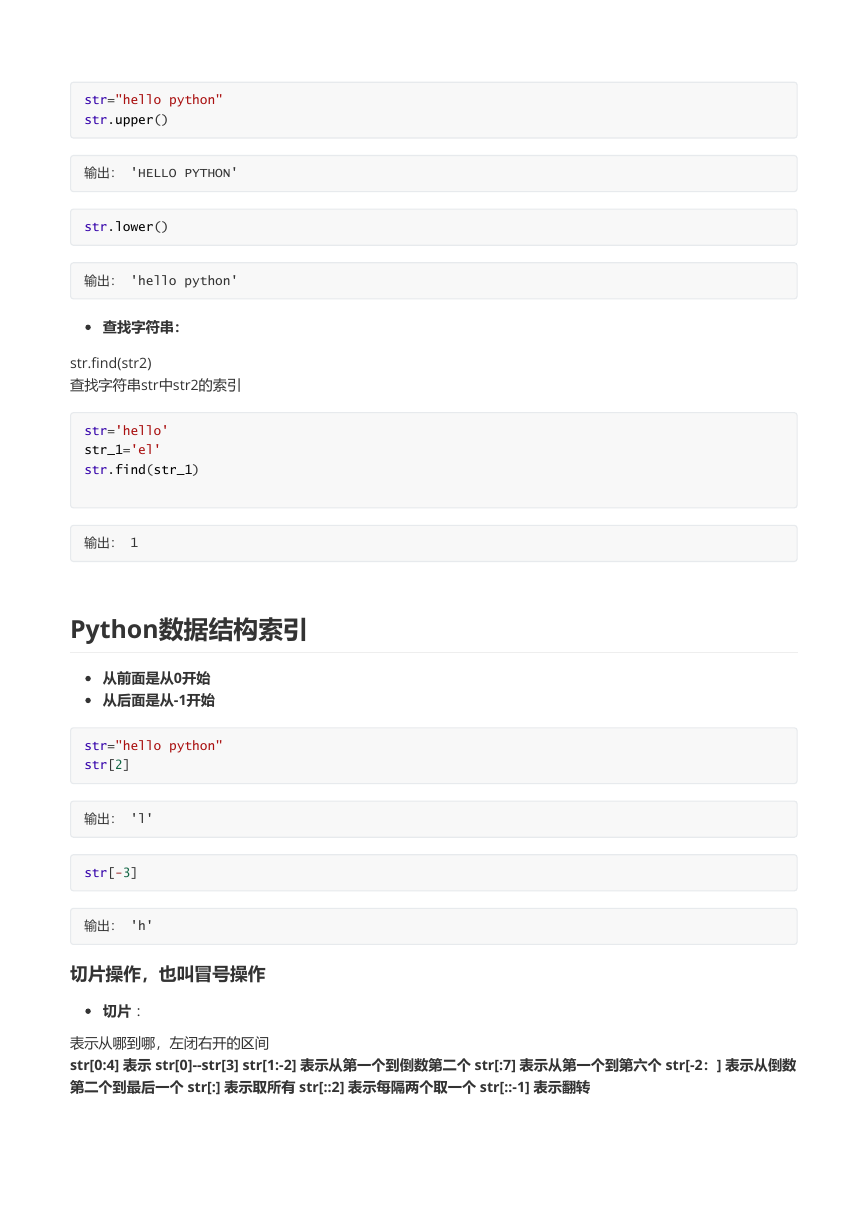


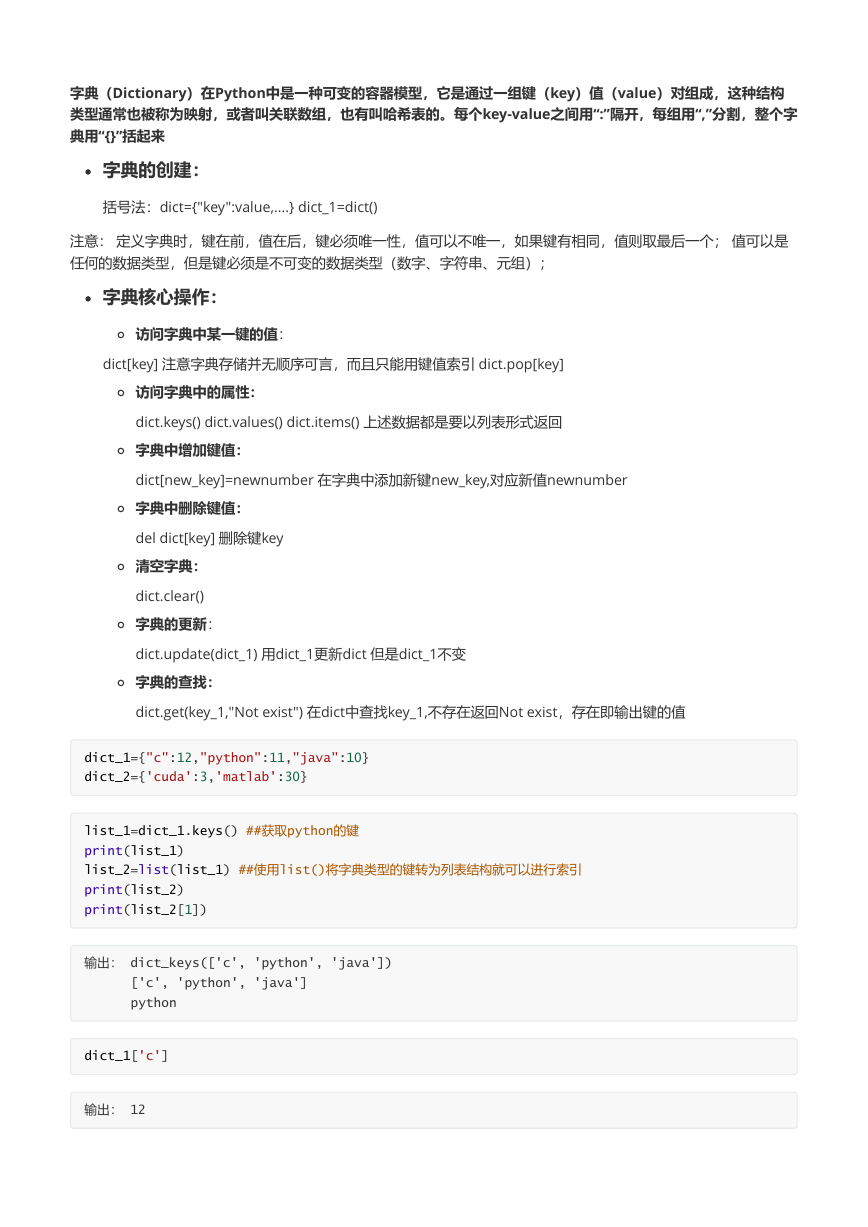








 2023年江西萍乡中考道德与法治真题及答案.doc
2023年江西萍乡中考道德与法治真题及答案.doc 2012年重庆南川中考生物真题及答案.doc
2012年重庆南川中考生物真题及答案.doc 2013年江西师范大学地理学综合及文艺理论基础考研真题.doc
2013年江西师范大学地理学综合及文艺理论基础考研真题.doc 2020年四川甘孜小升初语文真题及答案I卷.doc
2020年四川甘孜小升初语文真题及答案I卷.doc 2020年注册岩土工程师专业基础考试真题及答案.doc
2020年注册岩土工程师专业基础考试真题及答案.doc 2023-2024学年福建省厦门市九年级上学期数学月考试题及答案.doc
2023-2024学年福建省厦门市九年级上学期数学月考试题及答案.doc 2021-2022学年辽宁省沈阳市大东区九年级上学期语文期末试题及答案.doc
2021-2022学年辽宁省沈阳市大东区九年级上学期语文期末试题及答案.doc 2022-2023学年北京东城区初三第一学期物理期末试卷及答案.doc
2022-2023学年北京东城区初三第一学期物理期末试卷及答案.doc 2018上半年江西教师资格初中地理学科知识与教学能力真题及答案.doc
2018上半年江西教师资格初中地理学科知识与教学能力真题及答案.doc 2012年河北国家公务员申论考试真题及答案-省级.doc
2012年河北国家公务员申论考试真题及答案-省级.doc 2020-2021学年江苏省扬州市江都区邵樊片九年级上学期数学第一次质量检测试题及答案.doc
2020-2021学年江苏省扬州市江都区邵樊片九年级上学期数学第一次质量检测试题及答案.doc 2022下半年黑龙江教师资格证中学综合素质真题及答案.doc
2022下半年黑龙江教师资格证中学综合素质真题及答案.doc